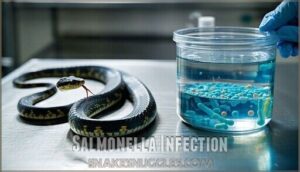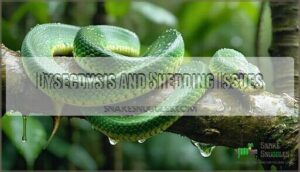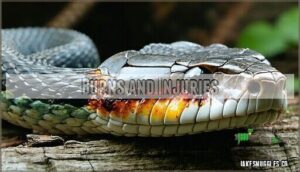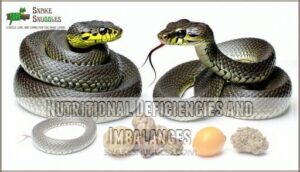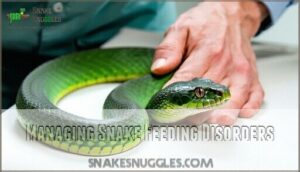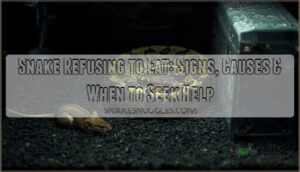This site is supported by our readers. We may earn a commission, at no cost to you, if you purchase through links.

Environmental issues—wrong temperatures, inadequate hiding spots, or handling stress—commonly trigger these problems. Underlying health conditions including parasites, infections, or metabolic diseases can also cause feeding disruptions.
Overfeeding creates its own set of troubles, leading to obesity and digestive complications. Proper diagnosis requires examining your snake’s habitat, feeding schedule, and overall health status.
Most feeding issues resolve with environmental adjustments, veterinary care, and patience. Understanding the root causes makes all the difference in your snake’s recovery.
Table Of Contents
- Key Takeaways
- Snake Feeding Issues
- Common Snake Health Problems
- Feeding Practices and Mistakes
- Reptile Disorders and Diseases
- Managing Snake Feeding Disorders
- Frequently Asked Questions (FAQs)
- Do snakes have anorexia?
- What are the most common health problems seen in pet snakes?
- What if my Pet Snake refuses to eat?
- Why does my snake have winter anorexia?
- Why do snakes eat so much?
- Can a gravid snake eat with dystocia?
- What to do if a snake is struggling to eat?
- How do you know if your snake has a neurological disorder?
- What are the symptoms of python disease?
- Do snakes get refeeding syndrome?
- Conclusion
Key Takeaways
- Environmental factors cause most feeding problems – You’ll need to check temperatures, humidity, lighting, and enclosure size first, since these directly control your snake’s appetite and digestion.
- Distinguish between normal and concerning appetite loss – Your snake may refuse food during shedding or breeding season, but persistent refusal beyond two weeks, with weight loss, requires immediate veterinary attention.
- Poor husbandry practices create feeding disorders – You’re likely causing problems through incorrect prey size, inconsistent feeding schedules, or handling your snake too soon after meals.
- Early intervention prevents serious complications – You can resolve most feeding issues through habitat adjustments and veterinary care, but delayed treatment leads to malnutrition and potentially fatal health problems.
Snake Feeding Issues
When your snake refuses to eat, you’re dealing with anorexia—a common but concerning feeding disorder that can stem from normal behavioral patterns or serious underlying health issues.
Understanding the difference between temporary appetite loss and medical emergencies helps you respond appropriately and keep your snake healthy.
Anorexia in Snakes
Three out of four snake owners will encounter feeding refusal at some point.
Most snake owners will face feeding refusal—it’s part of reptile care, not a personal failure.
Snake appetite loss, or anorexia, represents one of the most common feeding disorders symptoms you’ll face.
Your snake’s refusal to eat doesn’t always signal danger—it’s often temporary during shedding or breeding seasons.
However, persistent anorexia causes serious starvation signs including weight loss and lethargy.
Understanding anorexia causes helps you distinguish between normal behavior and health emergencies requiring immediate refeeding methods.
Identifying environmental stressors is essential in addressing feeding issues in snakes.
Environmental Factors Affecting Appetite
Your snake’s environment directly controls its appetite more than you might realize.
Temperature stress from improper heating disrupts digestion, while incorrect humidity levels cause discomfort that kills hunger.
Lighting cycles must match natural patterns or your snake’s internal clock goes haywire.
Water quality affects overall health, and cramped enclosure size creates stress that shuts down feeding responses completely, due to temperature stress and improper heating.
Underlying Diseases Causing Anorexia
Beyond temperature and humidity problems, serious medical conditions often trigger feeding refusal in your snake.
Stomatitis, commonly called "mouth rot," creates painful oral lesions that make eating impossible. Gastrointestinal impaction from substrate ingestion blocks normal digestion, while organ failure affects metabolism and appetite.
Septicemia spreads through the bloodstream, causing systemic illness. Abscesses, gout, and various infections create chronic pain that suppresses feeding behavior completely.
Reptile owners should be aware of reptile health issues to provide proper care and prevent such serious medical conditions.
Diagnostic Tests for Anorexia
When your snake won’t eat, veterinary diagnostic tests become your detective tools.
Blood tests reveal infections, organ problems, or nutritional deficiencies that trigger anorexia. X-rays show impactions or internal blockages, while ultrasound examines organ health.
For deeper investigation, endoscopy allows direct viewing of the digestive tract, and biopsy samples confirm specific diseases affecting your reptile’s appetite.
Proper temperatures maintain healthy snake digestion, so verify the enclosure is adequately heated to support healthy snake digestion and prevent issues related to anorexia.
Common Snake Health Problems
Beyond feeding refusal, you’ll encounter several health issues that directly impact your snake’s appetite and wellbeing.
Understanding these common problems helps you recognize warning signs early and seek appropriate veterinary care before minor issues become serious complications.
Salmonella Infection
Most snakes carry Salmonella as asymptomatic carriers, making bacterial contamination a hidden threat in snake feeding disorders.
This gastrointestinal disease risk affects both snake health issues and human safety.
Salmonella transmission occurs through contaminated surfaces and poor hygiene practices.
You’ll need strict disinfection protocols when handling feeding equipment and enclosures.
Human risk increases without proper handwashing after contact with snakes or their environment, highlighting the importance of proper handwashing.
External and Internal Lumps
When abnormal swellings appear on your snake, you’re dealing with potential health concerns that require immediate attention.
These masses can signal everything from minor infections to serious cancers.
Here’s what you need to know about Lump Identification:
- External lumps – Check for visible bumps, which may indicate infections, parasites, or Benign Growths requiring Diagnostic Imaging
- Internal masses – Feel for organ enlargement or tumors through gentle palpation during routine handling
- Treatment approach – Veterinary assessment determines if Surgical Options or Post-Op Care protocols are necessary
Dysecdysis and Shedding Issues
While lumps can signal serious health issues, healthy snakes shed their skin regularly through a process called ecdysis.
When this shedding process goes wrong, you’ll encounter dysecdysis—difficult or incomplete skin shedding that can threaten your snake’s health.
| Shedding Problem | Primary Cause |
|---|---|
| Retained spectacles (eye caps) | Low humidity levels |
| Stuck shed patches | Improper temperature gradients |
| Incomplete shedding | Inadequate environmental conditions |
Monitor shedding frequency closely, as healthy snakes typically shed in one complete piece.
Aiding shedding requires increasing humidity and providing rough surfaces for rubbing.
Retained spectacles can cause permanent eye damage if left untreated.
Burns and Injuries
While shedding problems can be concerning, physical injuries pose immediate threats to your snake’s well-being.
Heat source burns occur from prolonged contact with lamps, hot rocks, or radiators, causing tissue damage. Prey-inflicted wounds from live rodents can create life-threatening injuries requiring emergency intervention.
Escape attempt injuries result from repeated contact with cage walls, leading to facial ulceration. Dystocia complications during egg-laying demand immediate veterinary care to prevent fatal outcomes.
Wounds should be cleaned to prevent bacterial and fungal infections and ensure the snake’s overall health and well-being.
Feeding Practices and Mistakes
Many snake owners unknowingly create feeding problems through poor timing, incorrect prey selection, or improper handling practices.
These common mistakes can lead to serious health issues including malnutrition, digestive problems, and feeding refusal that may require veterinary intervention due to poor timing.
Frequency and Scheduling of Meals
Getting your snake’s feeding schedule right prevents many health issues down the road.
Inconsistent feeding creates unnecessary stress and can trigger snake feeding disorders that affect your pet’s well-being.
Here’s how to establish proper feeding frequency:
- Hatchling frequency: Feed every 5-7 days for rapid growth
- Adult schedules: Feed every 10-14 days to prevent obesity
- Seasonal variations: Reduce frequency during breeding season
- Stress impact: Maintain consistent timing to minimize anxiety
- Monitor response: Adjust snake feeding schedules based on appetite
Snake feeding frequency depends on age, species, and season.
Young snakes need more frequent meals while adults thrive on less regular feeding patterns.
Many owners buy feeding supplies online.
Prey Size and Quality
Beyond meal timing, prey size and quality directly impact your snake’s health.
The "one-and-a-half times girth" rule prevents regurgitation and stress.
Poor prey quality introduces parasites and disease, while proper frozen thawing maintains nutritional value.
Many owners purchase reptile feeder rodents to guarantee a healthy food supply.
| Prey Factor | Best Practice | Common Mistake |
|---|---|---|
| Size Selection | 1-1.5x snake’s thickest point | Oversized prey causing impaction |
| Quality Standards | Healthy, parasite-free specimens | Diseased or heavily parasitized prey |
| Preparation Method | Proper frozen thawing techniques | Inadequate thawing losing nutrients |
| Dietary Rotation | Multiple prey species rotation | Single prey type causing deficiencies |
Nutritional Deficiencies and Imbalances
Quality prey is just the start—snake nutrition depends on more than what’s on the menu.
Nutritional deficiencies and imbalances sneak up when snake diet lacks variety or proper nutrients. Watch for these pitfalls:
- Vitamin Deficiencies (A, D3, E)
- Mineral Imbalances (calcium, phosphorus)
- Poor Protein Metabolism
- Lack of Dietary Diversity
- Metabolic Disorders from malnutrition
Always make certain you avoid improper thawing practices to maintain prey quality and ensure proper nutrients are provided to prevent metabolic disorders.
Handling Snakes After Feeding
You can’t handle your snake right after it eats—that’s asking for regurgitation and digestive stress.
Wait 48-72 hours before any handling to let digestion complete properly.
During this observation period, watch for signs of discomfort or snake feeding disorders.
Premature handling disrupts snake comfort and can trigger feeding aggression or stress responses that complicate future meals, leading to potential digestive stress.
Reptile Disorders and Diseases
Your snake can face serious health challenges beyond basic feeding problems, including bacterial infections, viruses, and parasites that directly impact their appetite and digestion.
These underlying diseases often require immediate veterinary attention to prevent life-threatening complications and restore normal feeding behavior, which can be influenced by parasites.
Septicemia and Bacterial Infections
Poor feeding practices can weaken your snake’s immune system, making septicemia a deadly threat.
This bacterial infection spreads through your snake’s bloodstream, causing red belly spots and breathing difficulties.
Septicemia causes include trauma, parasites, and unclean environments.
Bacterial sources often stem from opportunistic gram-negative bacteria.
Infection symptoms include lethargy, convulsions, and muscle control loss.
Antibiotic treatment requires aggressive therapy with drugs like ceftazidime.
Prevention strategies focus on maintaining clean enclosures and proper husbandry practices.
Adenoviruses and Viral Diseases
Adenoviruses strike reptiles like silent assassins, causing fatal liver and digestive tract diseases.
You’ll notice bearded dragons showing lack of energy, weight loss, and diarrhea before sudden death occurs.
Adenovirus diagnosis requires PCR tests or liver biopsies for confirmation.
Disease progression happens rapidly, overwhelming your snake’s immune response.
Viral shedding spreads infection between animals.
Preventative measures include quarantine protocols and proper hygiene practices to protect your collection from these devastating viral diseases, using proper hygiene.
Parasites and Protozoan Infections
Beyond viral threats, parasites pose another significant challenge to snake health. Roundworms, hookworms, and ascarids commonly infect reptiles, causing stomach ulcers and intestinal obstruction.
Protozoan infections like Entamoeba and Cryptosporidium trigger severe digestive issues, including regurgitation and weight loss. Parasite Identification requires fecal examination and veterinary care.
Protozoan Treatment involves antiprotozoal drugs and supportive care. Their Digestive Impact disrupts normal feeding patterns.
Preventative Measures include proper hygiene and quarantine protocols. Some parasites carry Zoonotic Risk, making veterinary consultation essential for reptile health.
Nutritional Disorders and Deficiencies
Nutritional disorders plague snakes when their diet lacks essential nutrients or contains imbalanced ratios.
Vitamin deficiencies and mineral imbalances disrupt protein metabolism, while poor dietary sources lead to malnutrition.
You’ll notice obesity risks from overfeeding, plus metabolic disorders from inadequate snake diet planning.
These nutritional deficiencies create cascading health problems requiring immediate dietary correction.
Providing fresh, clean water is also essential for their health.
Managing Snake Feeding Disorders
When your snake refuses to eat, quick action prevents serious health complications from developing. Effective management combines proper husbandry practices with professional veterinary care to restore normal feeding behavior.
Preventive Measures and Hygiene
Maintaining ideal hygiene standards forms your first line of defense against snake feeding disorders and related health complications.
- Cage Disinfection: Clean enclosures weekly with reptile-safe disinfectants to eliminate harmful bacteria
- Handwashing Protocols: Wash hands thoroughly before and after handling snakes or prey items
- Water Sanitation: Replace water bowls regularly and disinfect to prevent bacterial growth
To maintain a healthy environment, choosing the right cage disinfectant is vital.
Proper prey handling and enclosure cleanliness directly impact your snake’s digestive health and feeding response.
Veterinary Care and Diagnostic Tests
When your snake won’t eat, you need an experienced veterinarian who can perform a thorough physical examination and run essential blood tests.
Diagnostic imaging like X-rays reveals internal problems, while blood analysis detects infections or organ issues.
Parasite screening identifies hidden culprits, and biopsy techniques help diagnose tumors.
Though anesthesia risks exist, proper feeding disorder treatment requires these diagnostic tools, including thorough physical examination.
Treatment Options and Supportive Care
Once diagnostic tests identify the root cause, your veterinarian will recommend targeted treatment options.
Fluid Therapy restores hydration using subcutaneous or intracoelomic routes, while Assisted Feeding through tube feeding provides nutritional support without stress.
Antibiotic Use treats bacterial infections, and experienced veterinarians may recommend surgical intervention for severe cases requiring immediate medical treatment.
Monitoring Health and Behavior
How can you tell if your snake’s health is taking a turn for the worse? Watch for behavioral changes like decreased activity levels or unusual lethargy, which often signal underlying snake feeding disorders symptoms.
Monitor appetite patterns closely—sudden feeding behavior issues or refusal to eat can indicate serious problems. Track shedding patterns and examine feces regularly for abnormalities.
Consistent health monitoring helps you catch issues early.
Frequently Asked Questions (FAQs)
Do snakes have anorexia?
Yes, snakes can experience anorexia, which means they’ll refuse to eat.
It’s actually pretty common, especially in ball pythons.
You’ll notice this during breeding season, shedding, or when they’re stressed from poor temperatures or lighting conditions.
What are the most common health problems seen in pet snakes?
Over 70% of pet snake deaths stem from preventable husbandry mistakes.
You’ll most commonly encounter respiratory infections, mites, shedding problems, feeding issues, and mouth rot.
Poor temperature, humidity, or cleanliness typically triggers these conditions requiring immediate veterinary attention.
What if my Pet Snake refuses to eat?
When your snake won’t eat, check environmental factors first – temperature, humidity, and lighting affect appetite.
Breeding season, shedding, or stress can cause temporary refusal.
If it persists beyond two weeks, consult a veterinarian immediately.
Why does my snake have winter anorexia?
Your snake’s winter anorexia occurs because they’re naturally programmed to eat less during cooler months. This normal behavior mimics their wild brumation patterns, where metabolism slows markedly for survival.
Why do snakes eat so much?
Don’t put all your eggs in one basket – snakes don’t actually eat excessively.
They’re efficient predators that consume large meals infrequently, storing energy for extended periods between feedings, unlike mammals requiring daily nutrition.
This behavior highlights their unique approach to consumption, making them efficient predators in their natural habitats.
Can a gravid snake eat with dystocia?
A gravid snake with dystocia shouldn’t eat.
The egg-binding condition makes feeding dangerous since it can worsen the obstruction and cause serious complications.
You’ll need immediate veterinary care to resolve the dystocia first.
What to do if a snake is struggling to eat?
Racing heartbeats aren’t just for horror movies—your snake’s feeding struggle signals serious trouble brewing.
Check temperatures, humidity, and prey size immediately.
If environmental factors aren’t the culprit, contact your veterinarian for examination since underlying diseases often cause feeding difficulties.
How do you know if your snake has a neurological disorder?
Looking for neurological signs in your snake means watching for unusual behaviors like head tilting, loss of coordination, or "stargazing" where they twist their neck upward constantly.
This behavior often indicates serious nervous system problems.
What are the symptoms of python disease?
Python disease symptoms include lethargy, loss of appetite, respiratory issues, mouth rot, abnormal shedding, lumps or swellings, neurological signs like stargazing, regurgitation, and visible parasites or infections requiring veterinary attention.
Do snakes get refeeding syndrome?
Snakes don’t typically develop refeeding syndrome like mammals do.
However, you should still feed emaciated snakes carefully with smaller prey items initially.
Gradually increase meal size as your snake’s body condition improves to prevent digestive complications.
Conclusion
Like a key releasing a door, proper understanding opens the path to resolving snake feeding disorders.
You’ve learned that environmental stress, health conditions, and poor husbandry practices create most feeding problems in captive serpents.
Recognition of symptoms allows for early intervention through habitat adjustments, veterinary examination, and appropriate treatment protocols.
Your snake’s feeding behavior reflects its overall well-being, making consistent monitoring essential for long-term health management and successful recovery outcomes through proper understanding and environmental stress management.
- https://whitepython.com/wp-content/uploads/2012/07/Problematic-Snake-Feeding.pdf
- https://vcahospitals.com/know-your-pet/snakes-diseases
- https://www.youtube.com/watch?v=qBSekNhKOGk
- https://www.thesprucepets.com/what-to-do-if-your-snake-is-not-eating-1238176
- https://fycjournal.ucdavis.edu/sites/g/files/dgvnsk16091/files/inline-files/Combating-Hunger-Strikes-in-Captive-Snakes.pdf

